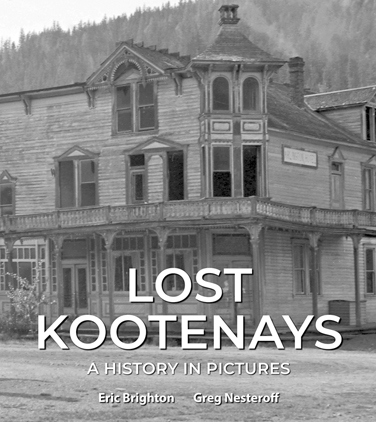Five Questions with Greg Nesteroff and Eric Brighton, authors of Lost Kootenays.
1. What is it about the Kootenay region that is so fascinating to everyone who visits?
Probably the immense diversity of its history and its stunning, wild landscapes. For better or worse, a lot has taken place here. The Ktunaxa and Sinixt First Nations inhabited this land for thousands of years before European settlers arrived, chasing the promise of mining, logging, or fruit farming. Kootenay history also includes the romance of steamboating, railroading, and ghost towns; the tragedy of residential schools and the internment of Ukrainian-Canadians and Japanese-Canadians; the arrival and enterprise of the Doukhobors; and the displacement of thousands of people for hydroelectric development. Today the Kootenays also draw people to take advantage of the region's many ski hills, golf courses, waterways, and hiking and cycling trails.
2. Why was it important for you to keep the Lost Kootenays Facebook group going?
We did it in tribute to a former administrator who died of cancer, but also in recognition of the site's large, loyal following and the resource that now exists in the thousands of photos that have been added.
3. The "Lost Kootenays" community has more than 50,000 followers on Facebook and is one of the most dynamic sites in British Columbia. Why is this subject so fascinating to so many people?
Nostalgia played a big role in growing the site early on, when it was dedicated more towards the 1950s through the '70s. But it has grown to be a clearinghouse for all matters related to local history, from any era. Membership has also increased steadily since Eric took over most of the posting with his gift for finding rare and dramatic pictures that captivate and intrigue our followers.
4. What surprised you most when you were researching this book?
That there are still so many outstanding images from a century ago or more that have never or rarely been published! We could have easily filled another volume with them.
5. Where did you find the photos in this book? Was there one that particularly stood out to you?
We started with the City of Vancouver Archives as they have an extensive collection of rare and high-resolution Kootenay pictures that they share freely with the world. Greg had his own collection of historical photographs, from which we were able to glean some extremely rare pics and ephemera for the book. We also did a wide search of other archives to find pictures never used before. And we were successful!
Finally, we rounded out our extensive collection of photos with a deep search of the BC Archives which has one of the largest, albeit most expensive, photo collections in Canada. Hundreds of hours went into searching for the pictures and then Eric spent countless further hours cleaning and editing them digitally. We took full advantage of photo-editing tools that were not readily available or affordable to use for books on similar subjects in decades past.
For the cover, we chose an image of the Arlington Hotel in Slocan City in its declining years. It evokes a ghost town vibe like few other pictures do. Another favourite is an amazing picture of a massive log jam on the Bull River in the 1910s. It highlights how dangerous and primitive methods were for getting logs to the mill. As historians, we've always felt a debt of gratitude to our forebears who sacrificed so much to get to where we are today.



Follow Us!